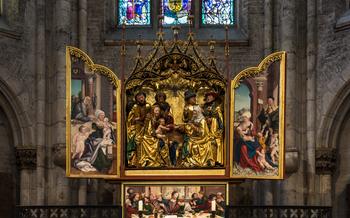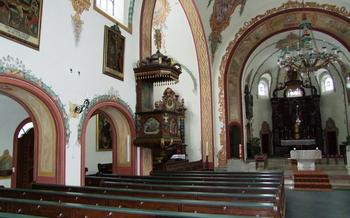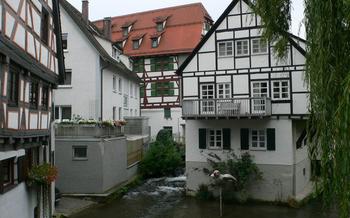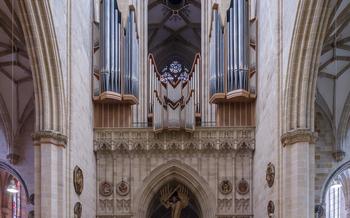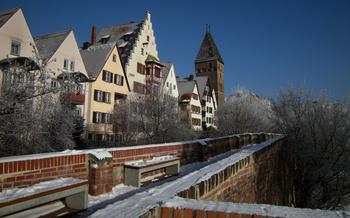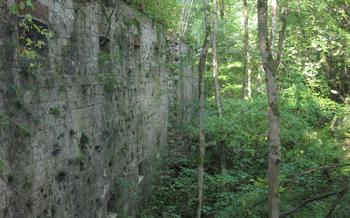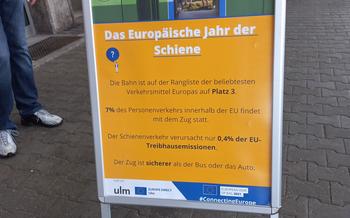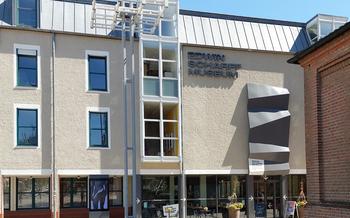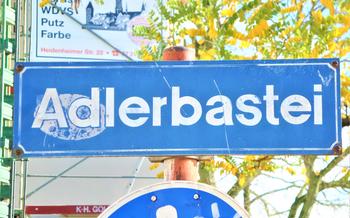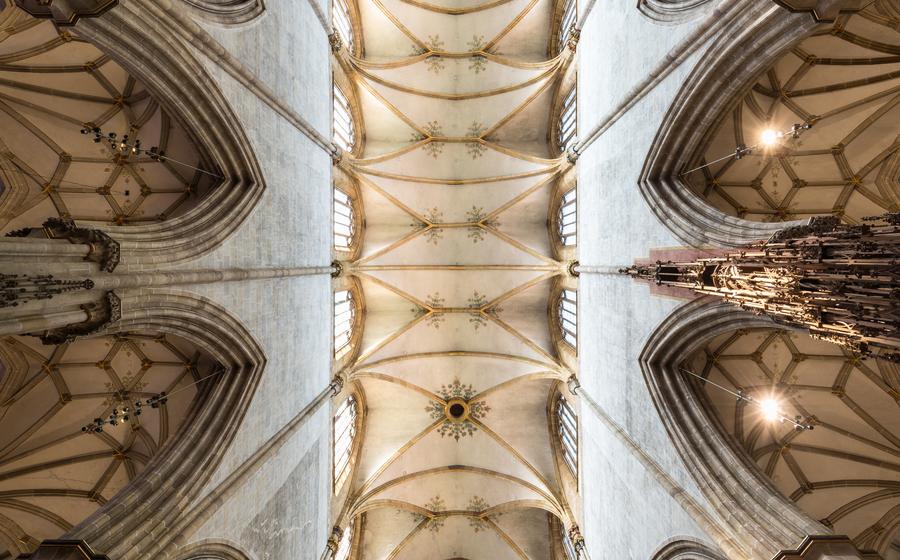
The Danube Swabian Museum (Donauschwäbische Zentralmuseum)
- The Danube Swabian Museum (DSZM): A Journey into the Past
- Location and Accessibility: Finding the Museum
- Hours of Operation and Admission Fees
- Guided Tours: Enhancing Your Visit
- Permanent Exhibitions: A Wealth of History
- Special Exhibitions: Unveiling New Perspectives
- Educational Programs: Learning and Engagement
- Research Facilities: A Treasure Trove for Scholars
- Museum Shop: Souvenirs and Treasures
- Café and Restaurant: Refreshment and Relaxation
- Accessibility for Visitors with Disabilities
- Family-Friendly Activities: Engaging Children
- Events and Programs: Beyond the Exhibitions
- Surrounding Attractions: Exploring Ulm
- Insider Tip: Hidden Gems and Local Favorites
The Danube Swabian Museum (DSZM): A Journey into the Past
The Danube Swabian Museum (DSZM) in Ulm, Germany, is a captivating institution dedicated to preserving and showcasing the rich heritage of the Danube Swabians, an ethnic German group that once thrived in the Danube River region of Central and Eastern Europe. Established in 1975, the museum serves as a central repository of the Danube Swabian culture, history, and traditions.
The Danube Swabians, also known as Donauschwaben, were a unique and vibrant community that settled in the Danube River valley centuries ago. They played a significant role in shaping the cultural and economic landscape of the region, contributing to agriculture, trade, and industry. However, their way of life was tragically disrupted by the tumultuous events of the 20th century, including World War II and its aftermath. Many Danube Swabians were forced to leave their ancestral homes and seek refuge in other parts of Germany and beyond.
The DSZM stands as a testament to the resilience and perseverance of the Danube Swabian people. Through its extensive collection of artifacts, documents, and personal accounts, the museum narrates their extraordinary journey, from their humble beginnings in the Danube River valley to their forced displacement and eventual integration into new communities. A visit to the DSZM is not just a trip to a museum; it's an immersive experience that transports visitors back in time, allowing them to witness firsthand the triumphs, struggles, and enduring spirit of a remarkable people.
Location and Accessibility: Finding the Museum
The Danube Swabian Museum (DSZM) is conveniently situated in the heart of Ulm, Germany, at the address Donauschwäbisches Zentralmuseum, Schillerstraße 9, 89073 Ulm. Reaching the museum is a breeze, whether you prefer public transportation or private vehicles.
For those opting for public transport, the museum is well-connected by bus and tram lines. The nearest bus stop, "Donauschwäbisches Zentralmuseum", is right outside the museum's entrance, and several tram lines stop within walking distance.
For those arriving by car, the museum provides ample parking facilities. A spacious parking lot is available adjacent to the museum, ensuring that visitors can conveniently park their vehicles during their visit.
Hours of Operation and Admission Fees
The Danube Swabian Museum (DSZM) welcomes visitors during specific hours of operation to ensure a smooth and enjoyable experience. Planning your visit in advance is recommended to make the most of your time at the museum.
Opening Hours
- Tuesday to Sunday: 10:00 AM - 5:00 PM
- Closed on Mondays and public holidays
Ticket Prices
- Adults: €00
- Reduced Admission (students, seniors, disabled): €00
- Children under 18: Free admission
- Family Ticket (2 adults + 2 children): €00
Discounts and Concessions
- Groups of 10 or more visitors receive a 10% discount on admission fees.
- Holders of the Ulm City Pass or the Museum Card enjoy free admission.
- Free admission on the first Sunday of every month.
Guided Tours: Enhancing Your Visit
Elevate your experience at the Danube Swabian Museum by joining a guided tour. These informative and engaging tours are led by knowledgeable guides who will provide insights into the museum's exhibits, artifacts, and the fascinating history of the Danube Swabians.
Guided tours are available in English and German, ensuring that visitors from all over the world can benefit from this immersive experience. Tours typically last for about an hour and a half, allowing ample time to explore the museum's highlights while delving into the unique stories and traditions of the Danube Swabian people.
The cost of a guided tour is typically included in the museum's admission fee, making it an excellent value addition to your visit. To ensure a spot on a guided tour, it is advisable to book your place in advance, especially during peak tourist seasons.
Whether you are a history buff, a culture enthusiast, or simply someone looking to learn more about the Danube Swabian heritage, joining a guided tour at the Danube Swabian Museum will provide you with a deeper understanding and appreciation of this remarkable institution.
Permanent Exhibitions: A Wealth of History
The Danube Swabian Museum's permanent exhibitions take visitors on a journey through the history and culture of the Danube Swabians. Divided into several sections, the exhibits showcase the region's rich heritage, from its earliest settlements to the present day.
One highlight is the Hall of History, which provides a comprehensive overview of the Danube Swabian experience, from their arrival in the region in the 18th century to their forced displacement after World War II. Artifacts, documents, and interactive displays bring the past to life, shedding light on the challenges and triumphs of this resilient community.
Another must-see exhibit is the Hall of Culture, which delves into the unique traditions and customs of the Danube Swabians. Visitors can explore traditional costumes, handicrafts, music, and culinary delights, gaining a deeper understanding of the vibrant culture that has survived despite adversity.
The museum also features a Hall of Emigration, which focuses on the Danube Swabians' forced migration after World War II. Through personal accounts, artifacts, and multimedia presentations, visitors can learn about the hardships faced by the Danube Swabians as they were expelled from their ancestral homeland.
Interactive displays and multimedia experiences throughout the museum enhance the visitor experience, providing a deeper engagement with the exhibits. Touchscreens, audio guides, and short films bring the past to life, making history accessible and relatable for visitors of all ages.
Special Exhibitions: Unveiling New Perspectives
The Danube Swabian Museum complements its permanent collection with a dynamic program of special exhibitions, offering visitors the chance to delve into specific aspects of Danube Swabian history and culture. These exhibitions, typically lasting several months, showcase unique artifacts, documents, and multimedia presentations that provide fresh perspectives and insights.
Themes explored in past special exhibitions have ranged from the vibrant folk art and traditions of the Danube Swabians to their contributions to various fields, such as music, literature, and science. Visitors have had the opportunity to learn about the experiences of Danube Swabians during times of war and peace, their resilience in the face of adversity, and their enduring legacy in their homelands and adopted countries.
Special exhibitions often feature collaborations with other institutions, scholars, and artists, bringing together diverse expertise and perspectives. They serve as platforms for dialogue, research, and cultural exchange, inviting visitors to engage with the museum's collection and themes in new and thought-provoking ways.
Whether you are a history buff, a culture enthusiast, or simply curious to learn more about the Danube Swabians, the special exhibitions at the DSZM offer a rich and rewarding experience, complementing the museum's permanent collection and providing a deeper understanding of this fascinating community.
Educational Programs: Learning and Engagement
The Danube Swabian Museum (DSZM) goes beyond showcasing artifacts and preserving history; it actively engages visitors in the learning process through a variety of educational programs. These programs are designed to cater to different audiences, from school children to families and lifelong learners.
Workshops, lectures, and seminars are regularly organized on topics related to the Danube Swabian culture, history, and traditions. These events provide an opportunity for participants to delve deeper into specific aspects of the museum's collection and gain insights from experts in the field.
The DSZM also offers educational programs tailored specifically for schools and families. Interactive workshops and guided tours are designed to make learning fun and engaging for younger visitors. Through hands-on activities and interactive displays, children can explore the museum's exhibits while developing critical thinking and problem-solving skills.
Families can participate in themed events and workshops that encourage intergenerational learning and bonding. These activities provide a unique opportunity for families to discover the history and heritage of the Danube Swabians together, creating lasting memories in the process.
The DSZM's educational programs not only enhance the museum experience but also contribute to the preservation and transmission of the Danube Swabian culture to future generations.
Research Facilities: A Treasure Trove for Scholars
The Danube Swabian Museum (DSZM) is not just a place of exhibition and display; it is also a hub of scholarly research and academic inquiry. The museum houses a wealth of resources that are invaluable to historians, researchers, and anyone interested in the history of the Danube Swabians and the region.
The museum's library is a treasure trove of books, manuscripts, and documents related to the Danube Swabians. It contains a vast collection of historical records, personal accounts, and scholarly works. The archives hold a diverse range of primary sources, including photographs, maps, and artifacts that provide a glimpse into the lives and experiences of the Danube Swabians.
In addition, the DSZM has an extensive database that allows researchers to search and explore the museum's collection. The database includes digitalized documents, images, and archival materials, making it a valuable resource for remote research and study.
The museum's staff is dedicated to supporting researchers and scholars in their work. They provide assistance in accessing the collection, conducting research, and interpreting the historical materials. The DSZM also hosts regular seminars, workshops, and conferences that bring together researchers from around the world to exchange ideas and collaborate on projects.
Whether you are a student writing a thesis, a historian conducting research for a book, or simply someone interested in learning more about the Danube Swabians, the DSZM's research facilities offer a wealth of resources and opportunities.
Museum Shop: Souvenirs and Treasures
The Danube Swabian Museum offers a well-stocked museum shop where visitors can find a treasure trove of souvenirs and unique items related to the Danube Swabian culture. From traditional handicrafts to books and postcards, there is something for every taste and budget.
One of the highlights of the museum shop is the selection of handcrafted items, such as embroidered textiles, pottery, and wooden carvings. These beautiful pieces are made by local artisans and showcase the rich cultural heritage of the Danube Swabians. Visitors can also find a variety of books, both fiction and non-fiction, that explore the history, culture, and traditions of the Danube Swabians.
For those looking for a more affordable keepsake, the museum shop offers a range of postcards, magnets, and other small souvenirs. These items feature images of the museum's exhibits, as well as scenes from the Danube Swabian homeland.
By making a purchase at the museum shop, visitors not only take home a memento of their visit but also support the museum's ongoing work to preserve and promote the Danube Swabian culture.
Café and Restaurant: Refreshment and Relaxation
After immersing yourself in the world of the Danube Swabians, you might feel the need to recharge and relish a delicious meal. The museum offers a welcoming café and restaurant where you can satisfy your hunger and thirst. The café provides a cozy atmosphere to enjoy a cup of coffee or tea, accompanied by a tempting selection of cakes and pastries. If you prefer a more substantial meal, the restaurant serves a delectable menu featuring regional specialties and international favorites. Whether you choose to dine indoors or bask in the sunshine on the outdoor terrace, the museum's dining options offer a perfect respite amidst your cultural exploration.
Accessibility for Visitors with Disabilities
The Danube Swabian Museum is committed to providing an inclusive and welcoming environment for all visitors, regardless of their abilities. The museum is fully wheelchair accessible, with ramps and elevators ensuring that all levels of the building are easily accessible. For visitors with visual or hearing impairments, adapted tours and services are available upon request. The museum staff is always happy to assist visitors with any special needs or requirements, ensuring that everyone has an enjoyable and enriching experience.
Family-Friendly Activities: Engaging Children
The Danube Swabian Museum recognizes the importance of creating a welcoming and engaging environment for families with children. To that end, the museum offers a range of interactive exhibits and hands-on activities designed to capture the imagination of young visitors.
Children can embark on a journey through history as they explore the museum's exhibits, discovering the stories of the Danube Swabians and their unique culture. Interactive displays, such as touchscreens and multimedia presentations, bring the past to life and make learning fun.
The museum also hosts regular family-themed events and workshops, providing opportunities for children to engage with the museum's collection in a creative and interactive way. These events may include storytelling sessions, arts and crafts activities, and guided tours tailored specifically for families.
By offering these engaging and educational experiences, the Danube Swabian Museum ensures that children of all ages can enjoy and learn from its collection, fostering a lifelong appreciation for history and culture.
Events and Programs: Beyond the Exhibitions
The Danube Swabian Museum extends its cultural offerings beyond the confines of its exhibitions with a vibrant calendar of events and programs. These events not only enhance the museum experience but also provide opportunities to connect with the local community and culture.
Regular events at the DSZM include concerts featuring traditional and contemporary music, lectures by renowned scholars and experts on various aspects of Danube Swabian history and culture, and film screenings showcasing the rich cinematic heritage of the region. These events offer visitors a chance to delve deeper into the museum's themes and engage with the local artistic and intellectual community.
Special events during holidays and festivals add an extra layer of excitement to the museum's offerings. During Christmas, the museum hosts festive concerts and workshops, while Easter brings egg-decorating competitions and traditional folk performances. These events provide a glimpse into the vibrant cultural traditions of the Danube Swabians and create a warm and welcoming atmosphere for visitors of all ages.
Throughout the year, the DSZM also organizes special events and programs tailored for specific audiences. Family-friendly workshops and activities during school holidays engage children with interactive learning experiences, while guided tours in different languages cater to the needs of international visitors. These events not only promote cultural exchange but also ensure that the museum remains accessible and relevant to diverse audiences.
Surrounding Attractions: Exploring Ulm
The Danube Swabian Museum is situated in the heart of Ulm, a city that boasts a wealth of historical, cultural, and architectural treasures. Once you've delved into the fascinating world of the Danube Swabians, take some time to explore the city's other landmarks.
Start with a visit to Ulm Minster, an awe-inspiring Gothic masterpiece renowned for its intricate carvings and the world's tallest church steeple. Climb to the top for breathtaking panoramic views of the city and the surrounding countryside.
Stroll along the banks of the Danube River, a lifeline that has shaped Ulm's history and culture. Admire the picturesque Fishermen's Quarter, with its colorful half-timbered houses and traditional pubs. Take a refreshing boat trip to explore the river's tranquil waters and spot wildlife along the banks.
Discover the Ulm Museum, which houses an impressive collection of art, artifacts, and exhibits showcasing the city's rich past and vibrant present. Learn about Ulm's role in trade, science, and industry, and marvel at the stunning collection of medieval and modern art.
For a taste of contemporary culture, head to the Kunsthalle Weishaupt, a modern art museum that hosts thought-provoking exhibitions by renowned international artists. The museum's striking architecture, designed by renowned architect Max Dudler, is a work of art in its own right.
Ulm is also a culinary paradise, offering a diverse range of dining options from traditional Swabian cuisine to international flavors. Indulge in hearty dishes like Maultaschen (Swabian ravioli) and Spätzle (egg noodles), or savor the flavors of international cuisine at one of the city's many ethnic restaurants.
Insider Tip: Hidden Gems and Local Favorites
Beyond the main exhibits, the DSZM holds hidden gems that may surprise and delight visitors. One such treasure is the "Migration Hall," which offers a poignant glimpse into the personal stories and struggles of Danube Swabian families as they left their homeland. For a unique perspective, explore the museum's extensive collection of traditional costumes and textiles, showcasing the vibrant cultural heritage of the Danube Swabians.
To fully immerse yourself in the local culture, venture beyond the museum walls and explore the culinary delights of Ulm. Indulge in the region's famous Maultaschen, a type of Swabian ravioli, or savor a hearty plate of Käsespätzle, a traditional cheese-noodle dish. For a sweet treat, try the local specialty, the Ulmer Spatz, a delicate pastry filled with fruit and cream.
To experience Ulm like a local, take a leisurely stroll along the banks of the Danube River, admiring the picturesque views and vibrant atmosphere. Visit the iconic Ulm Minster, one of the tallest churches in the world, and climb to its observation deck for breathtaking city panoramas. Discover the charm of the historic Fishermen's Quarter, with its colorful half-timbered houses and cobblestone streets.
By embracing these insider tips, you'll uncover the hidden treasures of the DSZM and immerse yourself in the rich cultural tapestry of Ulm, ensuring a truly memorable and enriching experience.
